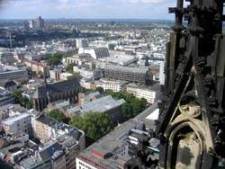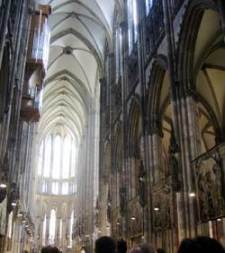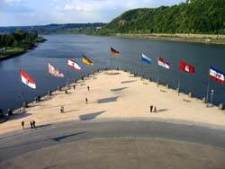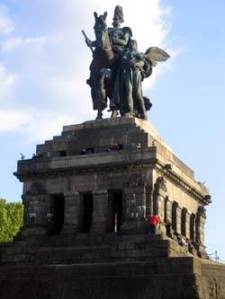|
We had planned to go to Trier on this day (Sunday) and Köln the next, but after realizing that many of the attractions in Köln were closed
on Mondays, we decided to visit Köln on Sunday and Trier on Monday. We had gone to bed early the previous night, so we were up before
7am. We got gas in the morning and then continued to Köln. We wanted to find a parking garage near the Köln Cathedral, but our map of Köln showed only the primary city streets. We parked at
an underground garage, but we were not sure where exactly we were in the city. There was a
machine to collect payments for parking, but we were not sure if we needed to pay before we left or after we had returned. We pressed a help
button on the machine, but no one spoke English on the other end. While we were trying to figure out the parking rules, a woman came out to
help. She didn't speak English either, but we were able to figure out that we didn't need to pay until later.
 We walked out of the parking garage and were excited to see that we were literally right outside the cathedral. It was still early,
and it seemed like there was hardly anyone in Köln. We hadn't eaten anything yet, and we were getting very hungry, so we walked around the city looking for
a place for breakfast that wouldn't cost too much and wouldn't take very long. Nothing looked promising, but we remembered the recommendation of a
co-worker and went to the train station to look for food. Train stations are a valuable resource for
European travellers even if they are not travelling by train. Most train stations never close and often have quick and inexpensive meals.
At the train station we also paid to use the bathroom, which were the most expensive we had seen in Europe (1.10 EUR) but also the cleanest. We shared
a croissant, an apfeltashe, and a cappucino before leaving the train station.
We walked out of the parking garage and were excited to see that we were literally right outside the cathedral. It was still early,
and it seemed like there was hardly anyone in Köln. We hadn't eaten anything yet, and we were getting very hungry, so we walked around the city looking for
a place for breakfast that wouldn't cost too much and wouldn't take very long. Nothing looked promising, but we remembered the recommendation of a
co-worker and went to the train station to look for food. Train stations are a valuable resource for
European travellers even if they are not travelling by train. Most train stations never close and often have quick and inexpensive meals.
At the train station we also paid to use the bathroom, which were the most expensive we had seen in Europe (1.10 EUR) but also the cleanest. We shared
a croissant, an apfeltashe, and a cappucino before leaving the train station.
 When we returned to the Köln Cathedral, mass was in session, and barricades prevented visitors from progressing more than a couple of meters into the
church. So, we paid one EUR each for "zwei studenten" to
walk up the south tower to the Glockenstube (bell tower), which houses the
largest swinging church bell in the world (24 tons). From the top of the south tower we could see Köln spread out beneath us.
The 509 steps of the stairs
were worn from the footsteps of many previous travelers.
When we returned to the Köln Cathedral, mass was in session, and barricades prevented visitors from progressing more than a couple of meters into the
church. So, we paid one EUR each for "zwei studenten" to
walk up the south tower to the Glockenstube (bell tower), which houses the
largest swinging church bell in the world (24 tons). From the top of the south tower we could see Köln spread out beneath us.
The 509 steps of the stairs
were worn from the footsteps of many previous travelers.
 Since we could not tour the cathedral yet, we decided to walk down to the Imhoff-Stollwerck Chocolate Museum.
On the way to the museum we walked halfway across the Deutzer Bridge, which crosses the Rhine River. From the Deutzer Bridge, there is a great
view of the Köln Cathedral & Groß St. Martin.
Since we could not tour the cathedral yet, we decided to walk down to the Imhoff-Stollwerck Chocolate Museum.
On the way to the museum we walked halfway across the Deutzer Bridge, which crosses the Rhine River. From the Deutzer Bridge, there is a great
view of the Köln Cathedral & Groß St. Martin.
 The Stollwerck Chocolate Museum houses a minature chocolate factory, as well as exhibitions about the history of the Stollwerck chocolate company and the history of chocolate
itself. There is also a small greenhouse that demonstrates the tropical conditions necessary for the growth of cocoa plants.
On display was a painting, reminiscent of Jackson Pollock's style, done entirely in chocolate. At the museum's cafe, we
had schwein steaks with mushroom sauce and vegetables for lunch. We ordered in German, but then the girl behind the counter started asking us
questions in German, so we told her, "Ich spreche nur ein bisschen Deutsch".
She asked, "English?", we said, "Yes", and the rest of our transaction went smoothly in English. The cafeteria seating offered a great view of the Rhine
and the traffic on it.
The Stollwerck Chocolate Museum houses a minature chocolate factory, as well as exhibitions about the history of the Stollwerck chocolate company and the history of chocolate
itself. There is also a small greenhouse that demonstrates the tropical conditions necessary for the growth of cocoa plants.
On display was a painting, reminiscent of Jackson Pollock's style, done entirely in chocolate. At the museum's cafe, we
had schwein steaks with mushroom sauce and vegetables for lunch. We ordered in German, but then the girl behind the counter started asking us
questions in German, so we told her, "Ich spreche nur ein bisschen Deutsch".
She asked, "English?", we said, "Yes", and the rest of our transaction went smoothly in English. The cafeteria seating offered a great view of the Rhine
and the traffic on it.
 We walked back to the cathedral and got an ice cream cone with tiramisu and vanilla. This was the first time we had gotten vanilla ice cream
in Europe, and we noticed that their vanilla tastes different from American vanilla. At first we were not even sure if we had gotten vanilla,
but we had vanilla again in Paris, and it tasted similar to the one we had in Köln.
We walked back to the cathedral and got an ice cream cone with tiramisu and vanilla. This was the first time we had gotten vanilla ice cream
in Europe, and we noticed that their vanilla tastes different from American vanilla. At first we were not even sure if we had gotten vanilla,
but we had vanilla again in Paris, and it tasted similar to the one we had in Köln.
We had tried several times to get into the cathedral, but
mass was always in session. But just as we decided to leave the city and head down to Koblenz, mass let out. We watched the recessional as
everyone left mass, and then we got the chance to look around inside the cathedral. The initial structure of the Köln Cathedral was finished in 1265 to house the bones of the Three Magi who traveled to Bethlehem to witness
the birth of the baby Jesus. The present form of the cathedral was not finished until 1880. Some highlights inside the cathedral include the oldest remaining
monumental crucifix of the western world (976 A.D.), along with many other religious artifacts from the 13th and 14th centuries.
 After we finished touring the cathedral, we decided we had enough time to see some of Koblenz if we hurried. Most of the places that we wanted to see
in Köln closed around 5pm, but in Koblenz we were most interested in seeing outdoor landmarks, which would never be closed.
Koblenz is located at the confluence of the Rhein and Mosel Rivers. The town owes its name to the military posts established by Drusus here around 9 B.C.
The "castle" constructed here was called "castellum apud confluentes", which means "castle at the confluence of the rivers".
After we finished touring the cathedral, we decided we had enough time to see some of Koblenz if we hurried. Most of the places that we wanted to see
in Köln closed around 5pm, but in Koblenz we were most interested in seeing outdoor landmarks, which would never be closed.
Koblenz is located at the confluence of the Rhein and Mosel Rivers. The town owes its name to the military posts established by Drusus here around 9 B.C.
The "castle" constructed here was called "castellum apud confluentes", which means "castle at the confluence of the rivers".
 Before stopping in Koblenz, we visited the
Festung Ehrenbreitstein on the east bank of the Rhein. This strategic stronghold was built around 1100, and later it served as the residence for the archbishops of Trier
and as the base for collecting tolls on the Rhein. While looking for the path to the fortress, we found a hiking trail that we thought would lead us in the
right direction. Unfortunately, the trail ended at a clearing with a tepee
and what might have been an upside down American flag, but we didn't get close enough to see.
Before stopping in Koblenz, we visited the
Festung Ehrenbreitstein on the east bank of the Rhein. This strategic stronghold was built around 1100, and later it served as the residence for the archbishops of Trier
and as the base for collecting tolls on the Rhein. While looking for the path to the fortress, we found a hiking trail that we thought would lead us in the
right direction. Unfortunately, the trail ended at a clearing with a tepee
and what might have been an upside down American flag, but we didn't get close enough to see.
We could not figure out how to get into the Festung Ehrenbreitstein, so after looking around the outside we returned to Koblenz.
At the tongue of land where the two rivers meet, an equestrian statue of Wilhelm I was originally erected in 1897.
It was destroyed in World War II, but the base was rebuilt and a copy of the statue was piously dedicated to the unification of Germany in 1993.
After driving back to the time-share, we drove into Gemünd and bought two pizzas at Da Sergio.
We ordered an "inferno" and a "funghi" and took them back to our room. The woman who was running Da Sergio was very friendly and spoke English.
The inferno was covered with strips of hot red chilis, and both pizzas were delicious.
|

